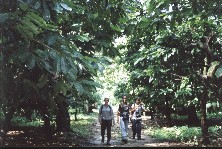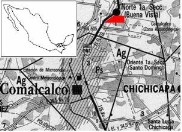|
PRIMATES IN AGROECOSYSTEMS: CACAO
PLANTATIONS (COMALCALCO, TABASCO, MEXICO)
|
Laboratorio de
Primatología Estación de Biología Los Tuxtlas,
Instituto de Biología, Universidad Nacional Autónoma de México |
|
David Muñoz Z., Programa de Posgrado, Colegio de la Frontera
Sur (ECOSUR), San Cristóbal de las Casas, Chiapas, México. Email: [email protected]
Alejandro Estrada, Laboratorio de Primatología, Estación de
Biología Los Tuxtlas, Instituto de Biología, Universidad Nacional Autónoma de
México. Email: [email protected]
Eduardo Naranjo, Colegio de la Frontera Sur (ECOSUR), San Cristóbal de las Casas, Chiapas, México. Email: [email protected]
Conversion of tropical rain
forests to pasture lands has resulted in diminished biodiversity and in the
local extinction of many plant and animal species, a serious loss for the local
inhabitants. In those cases in which the forest has not been completely
eradicated, the pasture dominated landscapes are occupied by remnant forest
fragments and by other patches of arboreal vegetation in which cultivated
fruiting trees are maintain by the local people as part of their subsistence
economy. Some of these arboreal plantations seem to favor the conservation of
wildlife. Our research in Los Tuxtlas and at other sites in southern
This approach has led us to investigate the value of certain types of agroecosystems for sustaining primate populations, as is the case of cacao, coffee and mixed plantations shaded with rain forest vegetation or by trees planted by local farmers.
Below we present a general
synopsis of our research with a small population of mantled howler monkeys
existing in a cacao plantation (Alouatta palliata) in the central part of the state of
|
|
|
|
|
|
The cacao plantation
under ¡nvestigation is located in the property of the chocolate factory farm
called " The plantation with the property comprises about 12 ha in which cacao trees are cultivated under the shade of Leguminosae trees. |
|
|
|
Mantled howler monkeys live in permanent social groups composed of several adult males, several adult females and a variable number of immatures. The cacao plantation under study harbors a large troop of howler consisting of 24 individuals and some solitary males and females. |
|
|
|
|
|
Field work
consists of daily observations of the feeding behavior of individuals in the
troop. Focal animal sampling is the observation technique employed. Records
are kept in each focal sample of the plant parts consumed. Each tree used by
the monkeys as a source of food items is marked, maesured (maximumheight and
dbh) and its location is space is determined with a GPS. Undergraduate and
graduate students participate as field assistants and we also have the
collaboration of students from the |
|
|
|
|
In this agroecosystem one finds tree species such as Samanea saman (Fabacea), Ficus spp (Moraceae), Gliricidia sepium ( Fabacea) and mango (Mangifera indica; Anacardiaceae) that provide the shade for the cacao trees (Theobroma cacao; Sterculiaceae) to grow and develop into fruit producing individuals. |
|
|
|
The cacao plantatioon is an agroecosistem very rich in rain forest animals, including not only the howler monkeys, but also other arboreal mammals, bats and a great number of bird species. This suggests an important conservation value of these agroecosystems for preserving segments of the tropical forest fauna. |
|
|
|
|
In addition
to the monkeys, the plantation is inhabited by arboreal procupines (Sphigurus mexicana) and marsupials
such as Didelphis virginianus.
Among the most common bat species present in the plantation we have Molosus sp, Artibeus jamaicensis and Sturnira lilium. Our work has also shown the
presence of 84 species of birds, of which 90% are forest interior species. |
|
|
|
|
|
The cacao plantation under study in Tabasco, as others we have investigated in Los Tuxtlas, are an important foci of conservation for primates such as howler monkeys and other forest animals.These fauna has foun refuge in the plantation and their existence does not interfere with the agricultural activity. In fact the fruit-eating activities of monkeys, birds and bats contribute to the dispersal of seeds of many native plants present in the plantation, restoring the forest along its edges. Similarily, insectivorous birds and bats are an important natural control of populations of insects that may become pests to the plantation. |
|
|
|
Adjacent to
the plantation is the Mayan site of Comalcalco, the northernmost Mayan city
in |
|
|
We are grateful to
the Valenzuela Riveroll family, owners of the chocolate farm " |
|
|
Publicatiosn related to the
topic of primates and other rain forest fauna in agroecosystems
Raboy, Becky E. Christman Mary C. and Dietz James M.
2004. The use of degraded and shade
cocoa forests by Endangered golden-headed lion tamarins Leontopithecus
chrysomelas Oryx Vol 38 No 1 January 2004
Estrada, A.
& Coates-Estrada, R. 2002.
Bats
in Continuous forest, forest fragments and in an agricultural mosaic
habitat-island at
Estrada, A.,
Rivera, A. & Coates-Estrada, R. 2002.
Predation of artificial nests in a fragmented
landscape in the tropical region of
Estrada, A. & Coates-Estrada, R. 2002. Dung beetles in continuous
forest, forest fragments and in an agricultural mosaic habitat-island at
Ibarra, A.,
Estrada, A. & Arriaga, S. 2001.
Avifauna asociada a dos cacaotales tradicionales en la region de la Chontalpa,
Tabasco, México. UNIVERSIDAD Y CIENCIA
17:101-112.
Estrada,
A. & Coates-Estrada, R. 2001. Bat species richness in live
fences and in corridors of residual rain forest vegetation at
Estrada, A.,
Coates-Estrada, R., Anzures, A. & Cammarano, P. 1998. Dung and carrion beetles in tropical rain forest fragments and
agricultural habitats at
Estrada, A., R. Coates-Estrada & D.
Meritt, Jr.1997. Anthropogenic
landscape changes and avian diversity at Los Tuxtlas, Mexico. BIODIVERSITY AND CONSERVATION 6:
19-43.
strada, A. R. Coates-Estrada & D.
Meritt, Jr. 1994. Non flying
mammals and landscape changes in the tropical rain forest region of Los
Tuxtlas, Mexico. ECOGRAPHY 17:229-241.
Estrada, A., R. Coates-Estrada & D.
Meritt, Jr. 1993. Bat species richness and abundance in tropical
rain forest fragments and in agricultural habitats at Los Tuxtlas, Mexico. ECOGRAPHY 16: 309-318
APOYA LA
CONSERVACION DE LAS SELVAS DE TABASCO
Copyright @ 2003 Alejandro
Estrada


